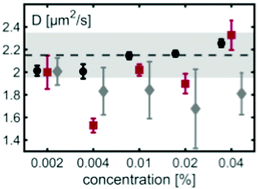The hitchhiker's guide to quantitative diffusion measurements
Abstract
Quantifying diffusional motion of submicron tracer particles with high spatiotemporal resolution is often key to assess the dynamics of physico-chemical systems, e.g. in complex fluids, colloidal suspensions, or living cells. A variety of methods has been developed over the past decades, but often their quantitative comparability has remained poorly explored on an experimental basis. Yet, knowing their experimental benefits and limitations can be a crucial piece of information when designing experiments on new and unexplored specimen. Therefore, we have implemented three very widespread techniques for quantifying diffusional motion (single-particle tracking, fluorescence correlation spectroscopy, and differential dynamic microscopy) in a light sheet microscope and performed a quantitative comparison on standardized samples of varying concentrations. Light sheet microscopy is particularly suited for imaging-based diffusion measurements because of its high spatiotemporal resolution in combination with an improved contrast and signal-to-noise-ratio at low excitation powers. As a result, all three methods are found to yield good quantitative estimates with respect to the theoretically predicted diffusion constant, yet their accuracy and bias varies markedly, raising specific caveats for the individual methods' range of applicability.



 Please wait while we load your content...
Please wait while we load your content...